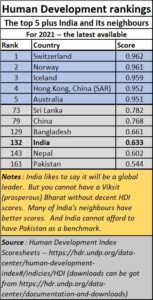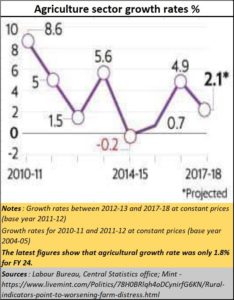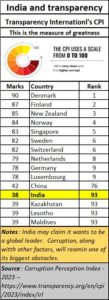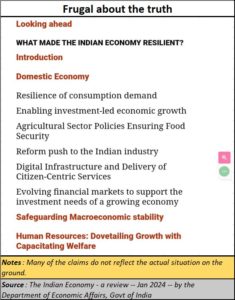Hallucinations of power and wealth – Budget 2024
By RN Bhaskar
The Bing generated image above is about a person’s hallucinations of power and wealth. In a way, the underpinnings of the Interim Budget 2024 presented before Parliament on 1 February 2024 appear to be based on such hallucinations.
Hallucinations are of two types. The ones conjured up by the policymakers are largely fantasies. The visions imagined by many from the lay public could turn out to be nightmares.
This is an important issue because the Budget is only an arithmetical exercise to the ways in which incomes and expenses match. The source of fund. The amounts spent under each head. Behind the numbers there is a philosophy, an intent. When the intent is flawed, the results are bound to be flawed. Hence this article seeks to look at some fundamentals that this Budget has overlooked, even though it remains an interim one.
As an article in Business Today points out (https://www.businesstoday.in/bt-tv/union-budget-2024/video/working-towards-making-india-a-viksit-bharat-by-2047-says-fm-sitharaman-415768-2024-02-01), “The ambitious goal set is to transform India into a “Viksit Bharat” by 2047, signifying a nation that is not only developed but flourishes in all dimensions – an aspiration that embodies progress, inclusivity, and permeation of growth across every level of society. Stated finance minister, Nirmala Sitharaman, “For our government, social justice is an effective and necessary governance model.”
 Social development not reflected in HDI
Social development not reflected in HDI
Rousing words indeed. But Viksit Bharat (or a prosperous India) can become a reality only when all sections of society can grow together. India trails many other countries when it comes either to employment, or even HDI. Its recent budget does not make any provisions for ameliorating the lot of distressed farmers who account for 50% of the population. And the country cannot be prosperous if consumption demand remains at a painful low (https://www.livemint.com/market/mark-to-market/rough-terrain-for-fmcg-cos-amid-sluggishrural-demand-11703579703169.html).
This points to a low purchasing power, and hence farm distress. Both Ashok Gulati and Purvi Thangaraj bemoan the fact that the Budget neglects the farm sector (https://indianexpress.com/article/opinion/columns/ashok-gulati-and-purvi-thangaraj-write-the-interim-budget-2024-neglects-the-farm-sector-9139714/).
Moreover, without any additional outlay for education and healthcare – both sectors have been languishing (free subscription — https://bhaskarr.substack.com/p/the-state-of-education-in-india) there is a clear danger that the strength that will be visible will be that of mobs running riot on the streets as they are NINJAs (people with no income, jobs or assets). More on this was discussed last week in these columns (https://bhaskarr.substack.com/p/what-after-the-ram-mandir?sd=pf).
As a market pundit put it, where is there any prosperity or strength in telling people that the government has provided 80 crore people with free meals. Strength and prosperity come into play when you can say that last year we fed 80 crore people. This year we had to feed just 60 crore. We pulled out 20 crore people away from doles into self-reliance or atma nirbharta.
Social justice includes fair play. The past few months have seen enforcement proceedings being initiated against elected representatives of the opposition parties. In Mumbai, the situation became more murky with the municipal corporation agreeing to release development funds only to those elected representatives who belong to the ruling party (https://indianexpress.com/article/cities/mumbai/bmc-mla-funding-part-1-express-exclusive-bjp-shiv-sena-9135593/). The implied message was that if other elected representatives wanted the money, they should first defect to the ruling party. It was called an “open loot of BMC funds” (https://indianexpress.com/article/cities/mumbai/bmc-maharashtra-govt-civic-body-9136523/).
In yet another development, the centre refused to transfer Rs.7,000 crore to West Bengal (https://www.newsclick.in/centre-withholds-rs-7000-crore-west-bengal-fails-display-pm-modis-photos-and-nfsa-logo-ration-shops). The funds were earmarked for the state government to procure paddy for central schemes (https://www.newindianexpress.com/nation/2024/Jan/19/west-bengal-no-signboards-with-pm-pix-at-ration-shops-central-government-holds-release-of-funds). The report said that “Despite repeated reminders, the West Bengal government has not “complied” with the Centre’s directive to display the NFSA logo and images of Prime Minister Narendra Modi at all ration shops across the state. This has prompted the Centre’s decision to withhold substantial financial assistance.”
Other stories of elected representatives being disqualified just before voting is to take place, and relatives and associates of opposition leaders being subjected to rains and threats of imprisonment, have made the waters extremely muddy. That can hardly be a testimony to either social justice or good governance.
Not surprisingly, India continues to rank poorly (93rd) on the Corruption Perception Index, 2023 brought out each year by Transparency International. Sadly, India is at the same level as Kazakhstan, Lesotho, and Maldives. Not among the biggest and best five in the world.
Moreover, it is ironic that the FM speaks of women being a focus group for the government. Sounds nice, but do recall the way the rapists of Bilkis Bano were allowed to go Scott free, only to be put back into prison by the Supreme court, not by the government (https://www.thehindu.com/news/national/a-classic-case-of-using-the-sc-to-violate-the-law-bilkis-bano-verdict/article67720401.ece). Instead, we heard a member from the ruling party who defended the rapists (https://www.ndtv.com/india-news/bilkis-banos-rapists-are-brahmins-have-good-sanskar-bjp-mla-3266193) stating at some of the 11 men convicted for the rape of Bilkis Bano and released by the Gujarat government after 15-odd years in jail, are “Brahmins” and have “good sanskaar” (value systems). So, rape has become a good set of values?
And bear in mind that other rapists too were treated with kid gloves.
Ram Rahim (https://www.indiatoday.in/law/story/rape-convict-gurmeet-ram-rahim-granted-21-day-parole-2465378-2023-11-20) was granted parole three times – each time before elections.
Ditto with Asaram (https://www.ndtv.com/india-news/godman-asaram-gets-bail-in-forged-documents-case-to-remain-in-jail-for-sexual-exploitation-of-minor-3995516). Similarly, consider the manner in which this government – like the previous one – prefers to promote self-styled godmen, and not the mainstream religious leaders (https://www.firstpost.com/india/state-created-vacuum-of-real-spiritual-leaders-helped-flourish-self-styled-gurus-like-gurmeet-ram-rahim-4015111.html). The self-styled godmen are allowed to grab land, not subjected to income tax raids and in turn they often help the ruling government to win votes. Many of such godmen too have rape charges against them.
Speaking with Business Standard (https://www.business-standard.com/budget/news/decadal-perspective-modi-govt-has-pushed-the-pedal-on-growth-technology-124020101930_1.html), the FM talked about Dishanirdeshak baatein. She said that “The first of the five dishanirdeshak baatein (guiding principles) is social justice as an effective and necessary governance model. The second are four major ‘caste groups’ — the poor, women, youth, and farmers. The third is our focus on infrastructure: We are continuing the trend of the last four years where capex has been the route for revival — earlier from Covid and now for sustained growth towards the Viksit Bharat goal. The fourth is using technology as a huge opportunity. DPI (Digital Public Infrastructure) is bringing value addition to the economy and facilitating every sector. The fifth is the high-powered committee for extensive consultation on challenges arising from population growth and demography.” Many of these claims sound hollow.
Then take some of the claims about what has made the Indian economy resilient.
Enabling investment led growth – The fact is that foreign direct investment is at its lowest in the past 16 years (https://bhaskarr.substack.com/p/what-after-the-ram-mandir?sd=pf).
Resilience of consumption demand – Just listen to the cry of FMCG companies (https://www.business-standard.com/industry/news/automakers-shine-in-q2fy24-as-fmcg-companies-struggle-due-to-poor-demand-123111900709_1.html). The rich appear to have had few problems – demand for automobiles is up. But demand for goods purchased by common people has fallen.
 Agricultural sector policies ensuring food security – Agricultural growth stood at a dismal 1.8%. Agricultural wages are painful for small and marginal farmers (https://bhaskarr.substack.com/p/india-prognosis-2024?r=ni0hb&utm_campaign=post&utm_medium=web). More crops have been banned from forward trading, thus preventing farmers from discovering future prices. Imports of agricultural commodities that could be grown in India has continued – notably of edible oils (https://asiaconverge.com/2023/04/milk-imports-will-make-farm-distress-worse/). Exports of agri commodities have been banned in several cases. The list is long. Just providing free rice and wheat is not agriculture. Milk has a higher contribution to India’s GDP than rice and wheat put together. Yet, milk and its derivative products have been badly mauled (https://bhaskarr.substack.com/p/dont-shun-market-allocation-of-resources?sd=pf).
Agricultural sector policies ensuring food security – Agricultural growth stood at a dismal 1.8%. Agricultural wages are painful for small and marginal farmers (https://bhaskarr.substack.com/p/india-prognosis-2024?r=ni0hb&utm_campaign=post&utm_medium=web). More crops have been banned from forward trading, thus preventing farmers from discovering future prices. Imports of agricultural commodities that could be grown in India has continued – notably of edible oils (https://asiaconverge.com/2023/04/milk-imports-will-make-farm-distress-worse/). Exports of agri commodities have been banned in several cases. The list is long. Just providing free rice and wheat is not agriculture. Milk has a higher contribution to India’s GDP than rice and wheat put together. Yet, milk and its derivative products have been badly mauled (https://bhaskarr.substack.com/p/dont-shun-market-allocation-of-resources?sd=pf).
Digital infrastructure: One silver lining is the rapid increase in ecommerce. Yet, the long pending promise of setting up an ecommerce regulator has been shoved aside. You thus transact in less than a second, but wait for months and years to get a digital dispute resolved.
Evolving financial markets – great concept. But this has been done by taking away the International Finance Centre away from Mumbai where it was to be located, and taking it to the GIFT City. Moreover, rules are being redrafted to ensure that transactions that the rest of India cannot do, are permitted by the GIFT City. That is not growth. It is transfer of business with very severe political and financial consequences that will be known over the span of a few years.
Conclusion
As mentioned earlier, at one level, the Budget is merely a book-keeping exercise – pure arithmetic. What is crucial are the underlying strategies, the vision, and the commitment to growth and transparency. Many of the issues outlined above point to the penchant for sloganeering, and mouthing well-sounding phrases. But the underpinnings are either missing, or have been distorted.
India needs to become great. And that cannot happen with better human development indicators, which includes education, health and a higher per capital income for the middle and lower middle classes. Currently, it is an average, which the high incomes of the affluent help mask the gravity of the situation. Budgets need more vision, and more discussion.








































COMMENTS